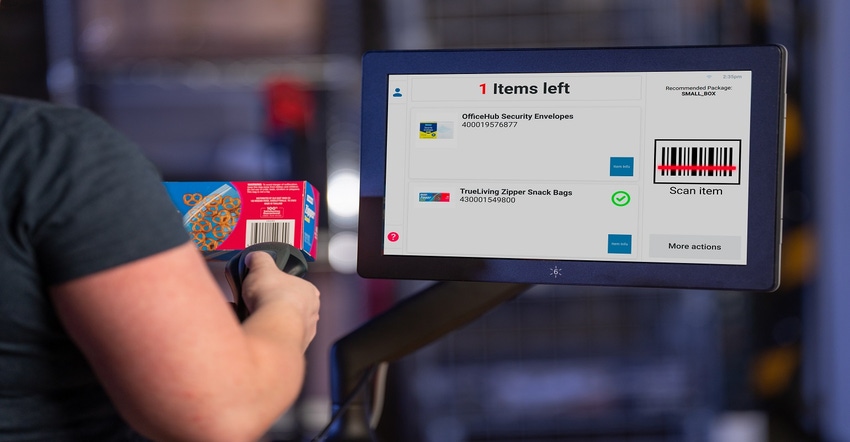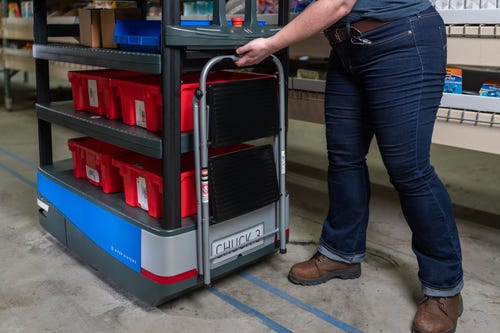How to Build a Better Warehouse Fulfillment Operation
6 River Systems added new hardware and software features to its wall-to-wall fulfillment solution to enhance productivity and flexibility for warehouse operators.
October 24, 2022

To improve its warehouse fulfillment solutions, 6 River Systems integrated its SaaS-based Fulfillment Execution System and autonomous mobile robot (AMR), Chuck. One advancement was the addition of the Universal Terminal. This tool incorporates packout and sortation workflows into a single device. It incorporates a touchscreen with a common user interface to make training fast and easy.
This modern interface allows managers to move associates between workflows with minimal cross-training. The goal was to increase the flexibility of the existing workforce to meet shifting bottlenecks. The unit is designed to be universally mountable with adjustable height, making it ergonomically friendly while freeing critical benchtop space.

6 River Systems also developed a Workspace Tray to make tasks like splitting cases and counting small pieces easier and faster. Also, the Chucks robots now have a vertical and European ladder mount so associates can carry ladders with them to reach SKUs located higher on the racks.
We caught up with Matt Fitzgerald, director of product management at 6 River Systems get the story behind the warehouse operations system’s hardware and software improvements.
Design News: What were the pain points you wanted to overcome with this improved system?
Matt Fitzgerald: There is a common theme to the features being released in this launch: productivity. This theme applies to the High Priority Chuck, workspace tray, configurable shelf heights (ergonomics), quick access to ladders, and multiple work areas. All of these features were based on direct customer feedback and field studies on how we can help our customers improve operational efficiency. 6RS is successful when our customers are happy, and our goal is to be a partner in that success.
DN: Did some of the system designs include changes to existing tools such as the robot, Chuck?
Matt Fitzgerald: Yes. Take High-Priority Chuck as an example: we received feedback that operations managers wanted the ability to identify the Chucks with high-priority work on them. The managers intended to manually direct associates to specific Chucks. We took this solution a step further by not only presenting operations managers with that information but extending the information to associates too. That way, the system guides the user to the right place and eliminates the need for operations managers to do this manually.
Or, in the case of our hardware updates, feedback around the ergonomics was received from operators. Whether it was freeing up workspace on tables (Universal Terminal) or loading/unloading totes (configurable shelves), we listened to the needs of our customers and addressed those needs.
DN: The advances seem to be both hardware and software. Was the idea to address a handful of customer issues?
Matt Fitzgerald: This is on purpose. 6 River Systems offers a complete hardware and software system. We are always listening to customer feedback and using that feedback to influence our product development plans. In the end, the goal is to improve our customer’s productivity and lower their fulfillment costs to improve their margins and profits. We also look at enhancements that keep our system flexible to meet the needs of our customers today and into the future as their SLAs get tighter and their volume of units shipped grows.
DN: Do these changes come from customer requests or 6 River Systems’ research and development?
Matt Fitzgerald: It’s a combination of both. We listen to our customers and take that feedback into our product development prioritization process. We also conduct research in the field and observe users and managers as they go about their daily warehouse fulfillment tasks. Our User Experience team finds ways to make our system more user-friendly and efficient by observing tasks and obstacles to getting workflows completed most efficiently. This research gives us insights to improve our solution that customers can’t always articulate.
The third component we use for product development efforts is data. We analyze workflow data across our network of customer facilities to discover, validate and develop new functionality that adds value to our customers’ operations.
About the Author(s)
You May Also Like





